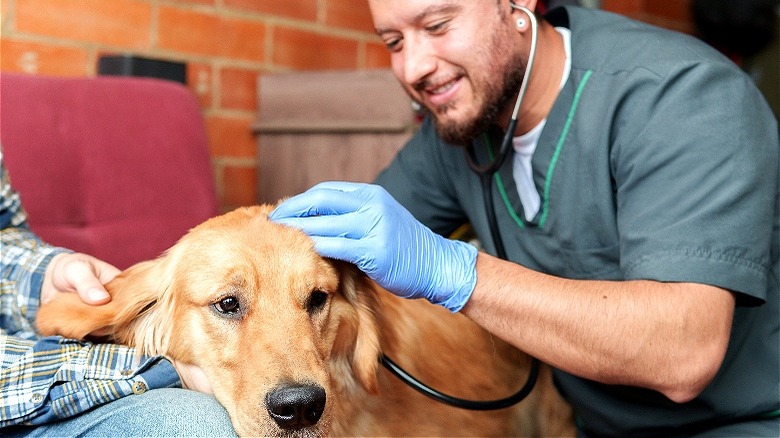How Much Should It Cost To Spay Or Neuter A Dog?
From abandoned "pandemic puppies" of workers forced to return to the office, to pets in households facing eviction and unstable housing circumstances (in the wake of huge price increases), increasing amounts of pets have entered the shelter system since the pandemic ended. Stephanie Filer, executive director of Shelter Animals Count, told CBS MoneyWatch that there were 250,000 more animals in the shelter system at the end of 2023 than there were the year before. Plus, data from the first quarter of 2023 showed a 30% intake increase for stray dogs since 2021. With more dogs on the street and in the shelter system, it's more important than ever to ensure your dog is spayed or neutered.
However, the financial impact of spaying and neutering can be a hurdle for many. Filer explained, "Animal shelters generally reflect what is happening to people in a community, and where there is food insecurity." That is, as more Americans struggle with inflation and rising costs, animal shelters experience growing numbers, too. Simultaneously, the financial burden of pet ownership can feel like a barrier that many families simply don't have the capacity to consider. This unfortunately means the exact pets most at risk of becoming strays or ending up in the shelter (aka the pets most in need of spay or neuter surgeries) are the pets most likely not to receive this care. However, it's important to realize there are many options available for spaying or neutering your dog, and prioritizing this care can ensure your furry companion's long-term health.
Cost considerations
There are a number of factors that can ultimately affect exactly how much your pet's spay or neuter surgery might cost, and how much your pet might cost in general (remember that Americans spend a LOT on their pets every year). For starters, spaying (which involves removing either the entire uterus or just the ovaries of a female dog) tends to be more expensive than neutering (the removal of a male dog's testes). This is due to the more complicated nature of the abdominal surgery required for female dogs. However, this does not include any abnormalities that might require more extensive scoping or exploratory requirements in the event of unusual anatomy (like, for instance, cryptorchidism or an undescended testicle). More complicated procedures will ultimately end up costing you more.
Similarly, the size of your dog can also increase the costs of the procedure, with large breed dogs typically requiring more anesthesia and having more potentially complicated outcomes. Larger dogs can lead to higher expenses, along with dogs that might be overweight and older dogs that might have higher health risks. It's important to realize that a spay or neuter procedure is ultimately surgery, which can be a serious medical procedure. It involves not just the medical expertise of the doctor but also anesthetic monitoring, intravenous fluids, and staff to make it all happen. Oftentimes vets will also want to include things outside of the actual surgery, such as preoperative blood work and postoperative pain medications, which can also increase your overall costs.
Average spay and neutering costs
Your geographic region can also be a significant factor for your pet's potential surgery costs, since more rural areas might not have as many competitively priced clinic options while urban areas might have generally more expensive offerings. With all of this in mind, the average cost to spay or neuter your dog can also vary depending on the type of facility offering the services. For instance, according to Rover, the average cost of a spay surgery for a dog at a private-practice veterinarian is between $262 and $578, while the average for a neuter procedure is between $196 and $470. However, low-cost spay/neuter clinics offer these services for an average cost between $40 and $100.
Also important to keep in mind is that certain cities, counties, or even states may offer voucher or assistance programs to help low-income families get their dogs spayed or neutered. Similarly, your local ASPCA, Humane Society, or other nonprofit clinic location could offer programs that make spaying and neutering more affordable. Be sure to research community-assistance programs and/or low-cost facilities in your area if the cost of a private veterinarian is too exorbitant for your budget. Also remember that, while spaying and neutering is extremely important for reducing the population of pets that end up in shelters every year, it can also prevent potential medical complications in the future for your furry companion. However, if you find yourself worried about future expenses, it might be worth researching if pet insurance is worth it for your family.


